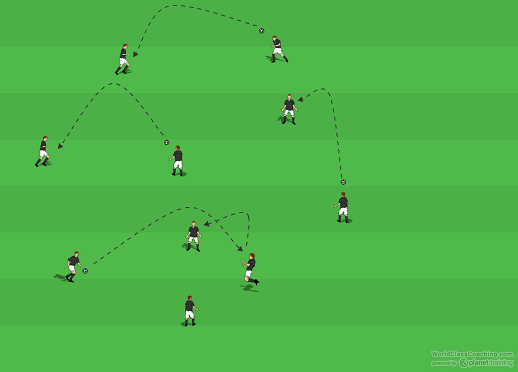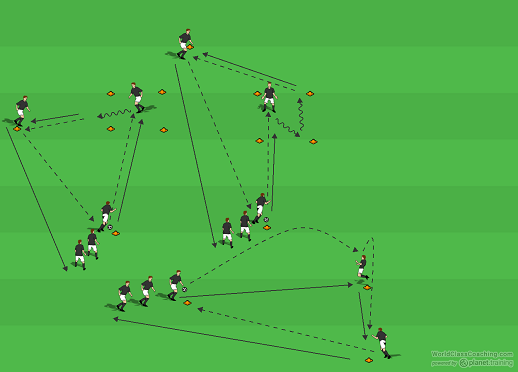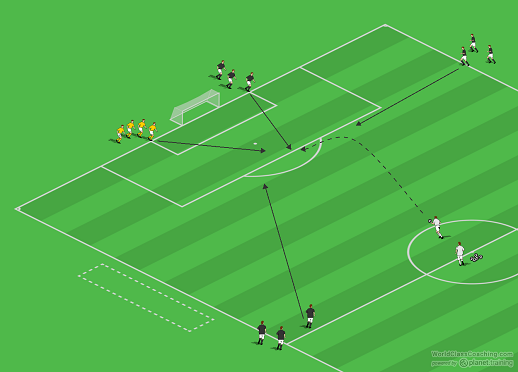By Mike Smith
Throw ins, Flicks, Trapping a Ball Out of the Air, Volleying and Turning. Have you ever had one of those games where just a little different bounce of the ball would have made a huge difference? Have you ever been the coach caught saying “ Unlucky” at least a dozen times a game? No one can be that unlucky. This lesson takes some times to focus on the areas where turning the bounces from unlucky to lucky can make all the difference.
Lesson 1
Bring it Down or Flick it On
Set-Up
Have your players get in groups of two and space out about 10 yards apart. With these exercises I like to keep the field cone free and also keep the groups somewhat close. I think the close quarters and business simulate a game environment to some degree. One of the groups will work with 4 players. The 4 player group starts with one player volleying the ball up into the air. Another player tries to flick the ball to either side where another group is waiting, and must bring the ball down. After 10 attempts, the groups rotate. The other groups have one player throwing the ball up to their partners who do 10 each of traps with the chest, the knee and the foot.

Coaching Points
The coach should review the basic points of bringing in the ball from the air, by cushioning and cradling the ball. The flick from the header should also cover some ground so the player receiving the ball is in a different space with different options than the player flicking the ball.
Lesson 2
Put Them in Motion
Set-Up
Set up 3 triangles in relatively close quarters. Two of the triangles will have a 3yd box at one point (as shown). Groups of 5 players rotate with in each activity and will change stations after 7-10 minutes of work at each. Starting from the bottom station and moving clockwise: Station 1 sees one player volley a ball to another player who attempts to flick the ball over to the third player who traps it down and passes it back to the start for another volley. Station 2 sees one player pass the ball, with pace, into the player in the box who must collect the ball with in the box and explode out with the ball towards the third player who will receive a pass and then pass back to the start to continue the drill. Station 3 sees a player drive a ball into the 3yd box where another player will collect the ball, dribble down to one corner of the box and then turn and explode out of the box. There the player in the box will pass to the third player who will receive the ball and pass it back to the start to keep things going.

Coaching Points
This is a great chance for the coach to challenge the players to keep the ball moving and execute the moves while at game speed. Communication and positive encouragement is also a good thing to emphasize here.
Lesson 3
Run to Goal and Build
Set Up
Have your keepers get in the center circle with a supply of balls. They will be serving various balls ( volley, thrown, rolled, bounced, etc…) to the top of the penalty area. One attacker will come from the end line ( as shown ) and attempt to collect the ball. A defender will also go for the ball as well. INITIALLY, the defenders should just be passive, get close enough to touch the attacker but allow the attacker to get the ball. As the drill progresses, this can build to a full on 50/50 ball with the defender clearing it back to the keepers if they win it. Additional attackers will move in, one from the half line and one from the touch line at the top of the penalty area ( as shown ) to support the attacking play. The attacker winning the ball must select the best option – flick on to supporting attacker, receive and pass to supporting attacker, collect the ball and attempt a turn, etc… Start by attacking an open net and eventually build pressure, add attackers and defenders and put one keeper in the goal.

Coaching Points
This is a great exercise to focus on taking chances and turning those unlucky moments into lucky ones. The coach should encourage the attackers to get aggressive and creative, keep the ball moving and attack with fluidity and speed. While an attacking based exercise, this is great for identifying those defenders who can clear well under pressure and end attacks before they start.
By Mike Smith
Currently the Head Coach for University Heights Academy Boys Soccer in Hopkinsville, KY , Mike is in his 14th year as a high school head coach with 23 years coaching experience overall and 34 year as a student and fan of the game. He holds a USSF D License.


